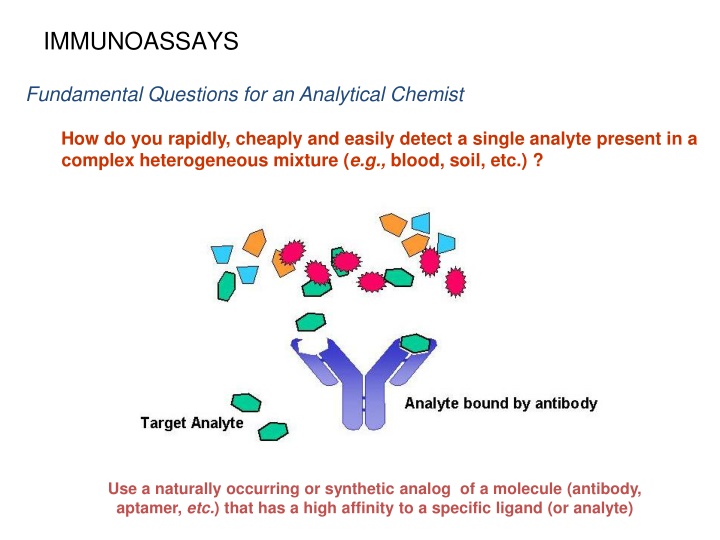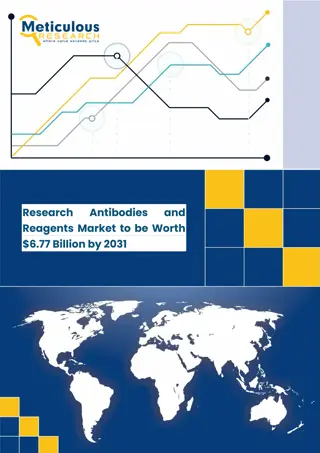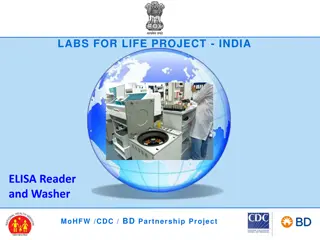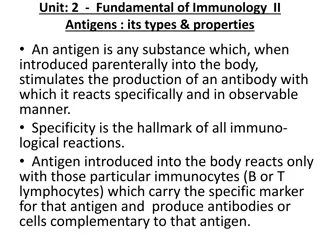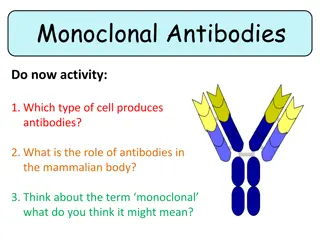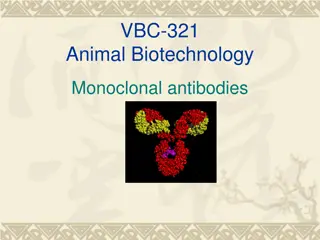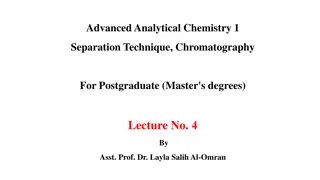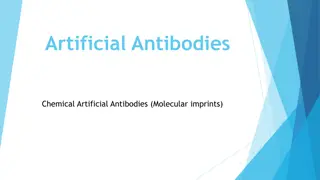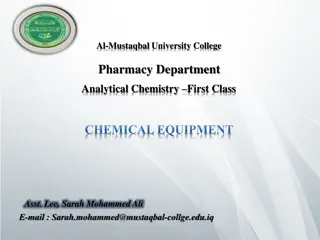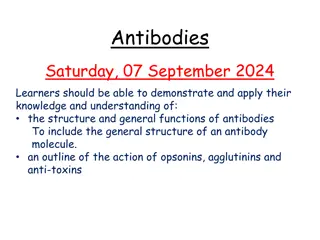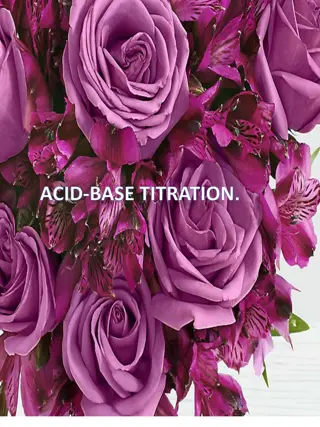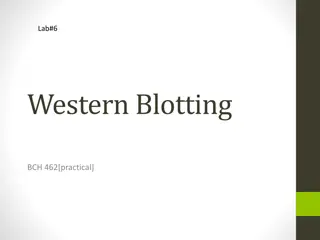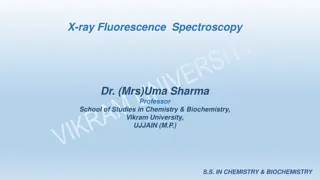Immunoassays and Antibodies in Analytical Chemistry
Immunoassays are analytical techniques utilizing antibodies to selectively determine components in samples. Antibodies, crucial in the immune system, bind antigens through specific interactions. The binding affinity is high, making immunoassays valuable for diverse applications like drug testing and environmental analysis.
Download Presentation

Please find below an Image/Link to download the presentation.
The content on the website is provided AS IS for your information and personal use only. It may not be sold, licensed, or shared on other websites without obtaining consent from the author.If you encounter any issues during the download, it is possible that the publisher has removed the file from their server.
You are allowed to download the files provided on this website for personal or commercial use, subject to the condition that they are used lawfully. All files are the property of their respective owners.
The content on the website is provided AS IS for your information and personal use only. It may not be sold, licensed, or shared on other websites without obtaining consent from the author.
E N D
Presentation Transcript
IMMUNOASSAYS Fundamental Questions for an Analytical Chemist How do you rapidly, cheaply and easily detect a single analyte present in a complex heterogeneous mixture (e.g., blood, soil, etc.) ? Use a naturally occurring or synthetic analog of a molecule (antibody, aptamer, etc.) that has a high affinity to a specific ligand (or analyte)
IMMUNOASSAYS Introduction I. Definition of an immunoassay: An immunoassay is an analytical technique which uses naturally occurring reagents known as antibodies for the selective determination of sample components Immunoassays are commonly used in a wide variety of areas, especially in biochemistry and clinical chemistry Examples of the application of immunoassay include: Drug testing Hormone testing (insulin in diabetic patients) Bacterial or viral testing (AIDS, hepatitis) Environmental testing (herbicides, pesticides) Advantages of immunoassays are: Inexpensive to perform Highly selective Low limits of detection Can have high-throughput. Often done in batch mode Applicable to the determination of a wide-range of compounds II. III.
IMMUNOASSAYS Antibodies I. Definition of an antibody: An antibody (Ab), or immunoglobulin (Ig), is a member of a family of glycoproteins that make up part of the body s immune system. Basic structure of an antibody: II. The above antibody consists of four polypeptides-two identical heavy chains (H) and two identical light chains (L) connected by disulfide bonds. These are arranged in a Y -shaped structure ending with two identical sites that recognize and bind a given foreign agent or antigen
IMMUNOASSAYS Antibodies II. Basic structure of an antibody: More realistic graphical representations of an antibody or Ig
IMMUNOASSAYS Introduction IV. Antibody Antigen Interactions: The body contains between 106 and 108 types of antibodies Each antibody has the ability to bind to a different foreign agent, or antigen (Ag) The ability of an antibody to recognize and bind a given antigen depends on the structure of its binding site Determined by the amino acid sequence of the antibody near the N-terminal ends of the heavy and light chains
IMMUNOASSAYS Introduction IV. Antibody Antigen Interactions: The general reaction between a single binding site on the antibody (Ab) and antigen (Ag) can be written as follows: Ka Ab + Ag Ab-Ag where Ka is the binding or association equilibrium constant The value of Ka is typically in the range of 106 to 1010 M-1 The binding is very selective and only occurs between Ab and Ag, or between Ab and molecules similar to Ag in their three-dimensional structure.
IMMUNOASSAYS Introduction V. Antibody Usage: The selectivity of Ab-Ag interaction makes antibodies useful as analytical reagents for the determination of specific components in mixtures Antibodies are useful as analytical reagents since they can be produced to a wide variety of substances: For large analytes (> 5,000 MW), antibodies can be produced by directly injecting the compound into an animal For small analytes (< 5,000 MW), antibodies can also be produced, but require that the compound first be coupled to a larger molecule, such as a protein, prior to injections Five classes of antibodies
IMMUNOASSAYS Introduction VI. Antibody Production - polyclonal antibodies : One common method for making antibodies to a substance (antigen) is to inject the analyte or analyte-protein conjugate into an animal several times over a period of a few weeks to a few months
IMMUNOASSAYS Introduction VI. Antibody Production polyclonal antibodies: If the agent is a foreign to the animal, the animal will develop antibodies to the agent and release these antibodies into its blood. After a few months, blood is removed from the animal and the antibodies produced are collected for use Antibodies produced in this fashion are typically very heterogeneous Recognize a number of different sites on the analyte Binding with a range of affinities (Ka) Heterogeneous antibodies are known as polyclonal antibodies Arise from several different lines of antibody-producing cells within the animal
IMMUNOASSAYS Introduction VII. Antibody Production - monoclonal antibodies (mAb): Monoclonal antibodies differ from polyclonal antibodies in that they are produced by a single cell line within the body All monoclonal antibodies from the same cell line recognize the same site on an analyte and bind with an identical binding affinity (Ka)
IMMUNOASSAYS Types of Immunoassays I. There are several different ways in which antibodies can be used in the detection or analysis of an antigen. Some common ways include: Precipitation-based immunoassay Competitive binding immunoassay Sandwich immunoassay All of these techniques use the specificity of antibodies as a means of selectively recognizing an analyte in the sample The analyte reacting with the antibody is then detected either directly or through the use of various chemical labels which produce easy to measure signals II. III. signal mAb antigen
IMMUNOASSAYS Precipitation assays I. Use the antibody as a selective precipitation reagent for the determination of analyte in the sample Involves the use of two or more types of antibodies that bind o different sites on the same analyte (i.e., polyclonal antibodies) Since each antibody has two binding sites per molecule, this can result in precipitates being formed between Ab and Ag Maximum precipitation occurs at some optimal Ab/Ag ratio Soluble Complexes Insoluble Complexes Soluble Complexes
IMMUNOASSAYS Precipitation assays I. To quantitate analyte by this technique, typically take multiple aliquots of sample and add various amounts of antibody to each sample (i.e., titration) The amount of precipitate formed for each aliquots is then determined visually, gravimetry, light scattering measurement, etc. II.
IMMUNOASSAYS Precipitation assays III. Technique can be performed in gels by having antibody and analyte diffuse towards each other from different sections of the gel A concentration gradient of Ab and Ag is formed in the gel Maximum precipitation will occur at the location where the antibody and analyte are both present in the correct ratio
IMMUNOASSAYS Precipitation assays IV. Precipitation in gels can be used either quantitatively or quantitatively to analyze the an analyte in the sample Ouchterlony assay: Qualitative method: formation of precipitate between sample and antibody wells indicates the sample contains analyte to which antibody binds Skamel et al. (2014): PLOS ONE. 10.1371/journal.pone.0113069.g009.
IMMUNOASSAYS Precipitation assays IV. Precipitation in gels can be used either quantitatively or quantitatively to analyze the an analyte in the sample Radial Immunodiffusion assay: Quantitative method: area of ring within precipitation band is proportional to concentration of analyte in sample
IMMUNOASSAYS Precipitation assays V. Advantages of precipitation methods Inexpensive-only reagent usually required is antibody Selective-few interferences from other compounds in sample Easy to perform VI. Disadvantages of precipitation methods Only useful for fairly high concentration analytes (10-200 mg/L) Long incubation times (hours-days) Can require large amounts of antibody
IMMUNOASSAYS Competitive binding immunoassays I. Quantitative method based on competition between analyte in sample and a fixed amount of labeled analyte for a limited number of antibody binding sites (equilibrium method) Indirectly measures the amount of analyte in the sample by looking at amount of labeled analyte it displaces from the antibody Unlabeled antigen Unlabeled antigen displaces labeled antigen
IMMUNOASSAYS Competitive binding immunoassays I. Quantitative method based on competition between analyte in sample and a fixed amount of labeled analyte for a limited number of antibody binding sites (equilibrium method) A typical calibration curve for the assay Linear transform Ln(antigen concentration)
IMMUNOASSAYS Competitive binding immunoassays II. Advantages of competitive binding immunoassay Can be used with any type of analyte Good limit of detection Theoretical limit: 1/Ka or 10-6 to 10-10 M Few interference from other compounds in sample III. Disadvantages of competitive binding immunoassay Some skill required to obtain optimum conditions for assay Long incubation times (hours-days) Limit of detection ultimately controlled by quality of antibody Antibody binding strength (Ka) Detection limit varies between different antibody preparations Usually manual method
IMMUNOASSAYS Sandwich immunoassays I. Quantitative method based on use of two antibodies to detect analyte First antibody extracts analyte from sample Second antibody (containing chemical label) identifies presence of analyte Unlabeled antigen Solid support antigen sandwiched between two antibodies This type of assay measures the amount of analyte in the sample by looking at the amount of labeled antibody that binds to analyte on the solid support
IMMUNOASSAYS Sandwich immunoassays I. Quantitative method based on use of two antibodies to detect analyte A typical calibration curve for the assay Response Concentration of Analyte
IMMUNOASSAYS Sandwich immunoassays II. Advantages of sandwich immunoassay Linear calibration curve Lower limits of detection possible than with competitive binding immunoassay < 10-12 M Greater selectivity than competitive binding assay Two antibodies instead of one are used to recognize analyte Shorter incubation times than competitive binding assay (hours vs. days) Less susceptible to variations in quality of antibody preparation then competitive binding assay III. Disadvantages of competitive binding immunoassay Only useful for large analytes 1000 to 2000 MW Requires enough room on molecule to bind two antibodies simultaneously Requires multiple antibodies per analyte Usually manual method
IMMUNOASSAYS Labels for Immunoassays I. The selectivity of a competitive binding assay depends on the specificity of the antibody The use of a chemical label is also required Several types of chemical labels have been used in immunoassays Limit of Detection Type of Label Example Measurement Principal I125 10-13 M Radiolabels Radioactive delay 10-10 M Fluorescein, Rhodamine Fluorescence Fluorescent 10-13 M Time-resolved fluorescence Rare earth chelates 10-11 M Horse radish peroxidase Formation of colored product by enzyme Enzymatic 10-13 M Acridinium esters, luminol Light production by chemical reaction Chemiluminescent
IMMUNOASSAYS Learning Objectives: 1. The student should be familiar with the general definitions and advantages of immunoassays and some examples of the application of this field. 2. The student should be familiar with important features, structure and the production of antibodies and the intrinsic value to immunoassays. 3. The student should be familiar with the differences between monoclonal and polyclonal antibodies 4. The student should be familiar with the details of the antibody-antigen binding interaction 5. The student should be familiar with the different types of immunoassays, be able to describe how the assays function, and understand their advantages and disadvantages: Precipitation-based immunoassay Competitive binding immunoassay Sandwich immunoassay Ouchterlony assay Radial Immunodiffusion assay 4. The student should be familiar with the different labels for immunoassays, including how the label is measured and the limit of detection: Radiolabels Fluorescent Enzymatic Chemiluminescent
